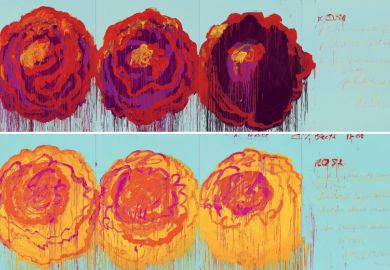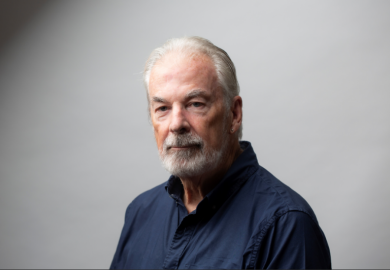In my troll-free science/arts social media bubble, The Poetry and Music of Science, by delightfully divertible physicist, Tom McLeish, has been making quite a splash. Its primary message, that science involves a huge degree of creativity, is one I perpetually proselytise, so I’m grateful for his systematic analysis of an array of artistic and scientific forms to lend scholarly substance to my anecdotal arguments. The book contains many of my favourite things: the three that punctuate the title, fiction, magnetic fields, Iris Murdoch, molecular chains, Virginia Woolf and two of my live professorial crushes. These are Patricia Waugh, who has been emblazoned on my consciousness ever since I saw her speak at an Iris Murdoch conference a few years ago (I remember that upon arrival she discovered that her dog had weed in her suitcase, necessitating the efficient purchase of a fabulous, last-minute outfit) and the wonderful Dame Gillian Beer, long-time literary friend of science.
I originally heard the name Tom McLeish in the context of the cross-disciplinary Physics of Life network, set up by UK government science funders, which aims to address the “grand challenge” of applying physics principles to a better understanding of biology, health and disease. In The Poetry and Music of Science, he proves himself a much more extreme interdisciplinarian, well deserving of his enviable post as chair of natural philosophy at the University of York, a role reclaimed from two centuries ago when science and arts were still officially facets of the same scholarship.
Every so often I go for breakfast with my friend Eleanor, who is a successful TV producer. We have known each other for many years through cycles of personal and professional peaks and troughs and I never fail to be amazed at how much our career trajectories have in common. We both chose to do something we love and have gradually been funnelled away from the practical side that attracted us, into project management, administration, financial planning, etc. Now in our forties, we spend our days coming up with ideas, iterating them through discussions with colleagues and collaborators, pitching at length to funding bodies, at which point many projects fall by the wayside through lack of support. If we are lucky enough to get the financial go-ahead, we then both experience the process of hiring and managing suitable staff to complete the work, keeping tabs on the creative process, disseminating the results and generating impact. McLeish’s book opens with a less jaded, more eloquent, version of this anecdote, describing his astonishment at the parallels between his process as a scientist, bringing new work to fruition, and that of an art professor colleague: “The discovery was mutual: if I had been surprised by the element of experimentation and trial in his artistic project, then he had not expected my story of science to speak so vitally of the role of the imagination.”
In the section titled “Music and Mathematics” I found my steepest learning curve, since I’m formally uneducated in both fields. It is a humbling test of one’s improvisational powers to be confronted with a taste of illiteracy, as I discovered in China some years ago. I can’t say I got to grips with the musical excerpts, although I certainly developed a longing for the beautifully described, transcendent, participatory experiences that can apparently be had by those truly attuned to classical music. Conversely, the initially scary-looking equations soon opened themselves up thanks to clear, first-principles, story-style explanations. Happily, all the illustrative science in this book is narrated with similar clarity. Suffice it to say that, after reading it, you will never again eat a stringy-cheesed pizza slice or a plate of noodles without picturing a morass of lengthy polymers squirming along under the influence of collected energetic forces.
McLeish is evidently religious; the first clue comes at the end of the preface, which is dated “Feast of St Barnabas, the Son of Encouragement”. While Faith and Wisdom in Science was the official subject of his last book, in 2016, and is not the overt focus here, this one too is woven through with ideas from religious thinkers such as Augustine and Anselm, especially in the section “Emotion and Reason in Scientific Creation”. McLeish also shares an obsession with the Book of Job, so common among literary experts.
Throughout the book, he emphasises the importance, and bemoans the paucity, of documented exploratory discussions between artists and scientists about their process. He is constantly trying to rectify this by getting people to reminisce about how their past projects have unfolded. He justifiably warns of the narrative challenges: “Admittedly it has never been easy to speak with clarity about moments of imaginative conception. When inspiration eventually comes, articulating the experience faithfully is fraught with difficulty.” He counters this with lyrical descriptions of the joy that can be gleaned from them, regardless of reliability: “A sparkling array of formerly hidden truth is open to a shared gaze, there is an immediate impression that as delights are plucked one by one, more will be found underneath – and overall a strong sense of personal discovery.”
Through McLeish’s investigations it becomes clear that “the more honest the story-telling in art or science, the more entangled and related became the experiences of emotion and cognition”. This was certainly the way things unfolded in a project that I created, which explores common methodology in the arts and sciences. This is called Viewing the Invisible (coincidentally echoing McLeish’s chapter title “Seeing the Unseen”) and involves artists painting portraits of people who have been influential in science in different ways. Their enlightening dialogues, as each divulged their ways of working over the course of the sittings, were recorded in films that we will be steadily releasing on social media in advance of a launch event at the National Portrait Gallery in September.
When I passed this volume around my alpha personality-dominated “popular science” book club as a suggested future selection, one member admitted that, way back when, she was wooed by her now husband quoting philosophers of science, Thomas Kuhn and Karl Popper, both of whose ideas feature here. Thanks to its poetic nature and compelling signposts for discussion, I suspect McLeish’s book would have aphrodisiac qualities for the right audience.
Expanding on the work of others, he concludes with an eight-stage breakdown for any kind of creative process: “Vision, desire, industry, constraint, incubation, illumination, verification and arrival.” He explains each of these in detail and I suspect that anyone will find ways in which their work fits within this frame. No matter what your field, you will come away from the book sold, as I am, on the need to prioritise time for creative gestation: “consciously fallow periods in which effort is relaxed, sometimes after frustrating and apparently fruitless labour”. It is the best investment we can make in our productivity, alongside getting enough sleep.
The book concludes that “Art and science share the same three springs of imagination”. These are the “visual image”, the “written and spoken word” and the “wordless depths of number, the musical and mathematical”. This could well be true of any discipline, if we consider there to be some that fall outside the category of “arts and sciences”, but perhaps that’s an argument for another book.
Rivka Isaacson is senior lecturer in chemical biology at King’s College London. A taster of her “Viewing the Invisible” project can be found at https://www.youtube.com/watch?v=92JExDU44dw
The Poetry and Music of Science: Comparing Creativity in Science and Art
By Tom McLeish
Oxford University Press, 384pp, £25.00
ISBN 9780198797999
Published 7 March 2019
The author
Tom McLeish, professor of natural philosophy at the University of York, grew up on the outskirts of London and studied at Emmanuel College, Cambridge. Collegiate life, he recalls, proved “a gift to someone who finds it hard not to be interested in everything. Though my degree was pretty straightforward theoretical physics, I enjoyed dropping into music lectures when I could, and one of the college fellows lent me his personal copy of the Prose Edda in translation when I mentioned an interest in Norse mythology.” He also became fascinated by a course on science and theology delivered by John Polkinghorne, a former physicist who had become an Anglican priest.
In giving talks to schools, McLeish has often “hear[d] from bright students that they had discontinued any study in science because they saw ‘no room for their imagination or creativity’ ”. This had made him realise that “in public voice and in education we had managed to portray science, disastrously, as a body of facts and formulaic method”, so he “determined to dig into the ‘silent narrative’ of the creative processes in science – and discovered rather more than I bargained for!”
Even today, in McLeish’s view, “the ‘Two Cultures’ division still casts its shadow over the way we learn and think and discuss”, something he regards as “a terribly debilitating fragmentation of learning and mind”. Writing The Poetry and Music of Science has taught him that the most radical ideas come not from “a narrow pursuit of a single question in isolation” but from “within a much wider mental engagement” – sometimes with other sciences and sometimes with “poetry, music, philosophy, history or theology”. He has seen this, for example, in his own “collaboration with medieval scholars on 13th-century natural philosophy. We started out helping them unpack some of the more mathematical and technical aspects of the texts – but ended up with a series of new science papers as well!”
Matthew Reisz
POSTSCRIPT:
Print headline: Imagination belongs to all
Register to continue
Why register?
- Registration is free and only takes a moment
- Once registered, you can read 3 articles a month
- Sign up for our newsletter
Subscribe
Or subscribe for unlimited access to:
- Unlimited access to news, views, insights & reviews
- Digital editions
- Digital access to THE’s university and college rankings analysis
Already registered or a current subscriber?








